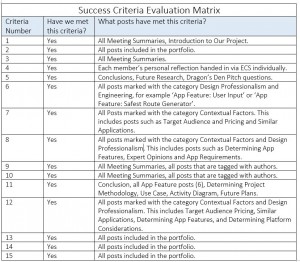At the beginning of the project a list of Success Criteria were identified, which were based upon the marking criteria for the assignment. At the end of the project the set of criteria would be evaluated against the work out-put recorded in the portfolio. To recap, our list of the 15 Success Criteria is shown below:
- To have submitted a project brief (approx 200 words) that summarise our project and how we will go about organising its different stages.
- To have kept a running blog (portfolio) of our activities as a group throughout the assignment process, on which each member will post work and research associated with the project.
- To have evidence of participating in meetings with their appointed project mentors, and with other members of the group throughout the assignment process. These can be found throughout the blog entitled ‘Meeting Summary’.
- To have submitted a reflective summary by each member of the project team at the end of the project.
- To present a summary of our project followed by a Q&A session at the end of the assignment.
- To have a project that uses design appropriate social network solutions and interface or extend the designs of existing social network infrastructures.
- To have written evidence of being able to identify and analyse social network characteristics in the portfolio.
- To have written evidence of being able to identify and interpret domain and societal requirements for the deployment of social network solutions in the portfolio.
- To have evidence of group work and group organisation throughout the entirety of the project.
- To have evidence of clear stages of planning and research throughout the project, with equal contributions from all members in a number of topic areas that may include design, research, graphics, and technical issues.
- To produce a finalised description of our project at the end of its course, which includes explanations of its different features, the methodology used to select these features, and a realistic prediction of how this product may be used by the target audience.
- To have clear evidence of market and user research which have been used to underpin the design and technological choices of the project.
- To have clear evidence of tailoring our project based on research undertaken, literature reviews and expert opinions.
- To have submitted a portfolio that demonstrates a social networking solution to a gap in the market which has been undertaken in a professional and well organised manner, and in an original way.
- To have a product that has been developed to the point of needing further testing and qualitative research (which requires funding more than our means, and more time). This means that the product, at its completion, will have extensive background research, design stages, and engineering designs and may only be improved through further testing to the wider public which we ourselves are unable to do. This is a realistic goal for our project as it demonstrates an ability to produce and work on a product to a high standard, but also realistic time management as this product has a limited time and is run alongside other courses and coursework.
The evaluation matrix of this can be seen here, please click to enlarge.
Written by Taekyun, Millie and Briony.
